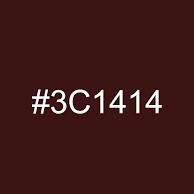Dark Sienna Brown
Dark Sienna (from Italian: terra di Siena, “Siena earth”) is an earth pigment containing iron oxide and manganese oxide.
In its natural state, it is yellow-brown and is called raw sienna.
When heated, it becomes a reddish brown and is called burnt sienna.
It takes its name from the city-state of Siena, where it was produced during the Renaissance.
Along with ochre and umber, it was one of the first pigments to be used by humans, and is found in many cave paintings.
Since the Renaissance, it has been one of the brown pigments most widely used by artists.
The first recorded use of sienna as a colour name in English was in 1760.
The pigment sienna and dark sienna was known and used, in its natural form, by the ancient Romans.
It was mined near Arcidosso, formerly under Sienese control, now in the province of Grosseto, on Monte Amiata in southern Tuscany.
It was called terra rossa (red earth), terra gialla, or terra di Siena.
During the Renaissance, it was noted by the most widely read author about painting techniques, Giorgio Vasari, under the name terra rossa.
It became, along with umber and yellow ochre, one of the standard browns used by artists from the 16th to 19th centuries, including Caravaggio (1571-1610) and Rembrandt (1606-1669), who used all the earth colours, including ochre, sienna and umber, in his palette.
By the 1940s, the traditional sources in Italy were nearly exhausted. Much of today’s sienna production is carried out in the Italian islands of Sardinia and Sicily, while other major deposits are found in the Appalachian Mountains, where it is often found alongside the region’s iron deposits. It is also still produced in the French Ardennes, in the small town of Bonne Fontaine near Ecordal.
Hex code on mom2B stock: #3c1414

Showing all 2 results

